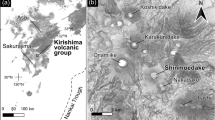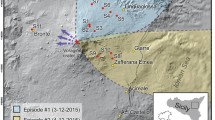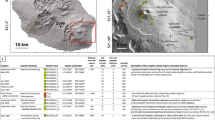Abstract
Ash fallout collected during 4 days of sampling at Stromboli confirms that a crystal-rich (HP) degassed magma erupts during the Strombolian explosions that are characteristic of the normal activity of this volcano. We identified 3 different types of juvenile ash fragments (fluidal, spongy and dense), which formed through different mechanisms of fragmentation of the low-viscosity, physically heterogeneous (in terms of the size and spatial distribution of bubbles) shoshonitic magma. A small amount (less than 3 vol%) of volatile-rich magma with low porphyricity (LP), erupted as highly vesicular ash fragments, has been collected, together with the HP magma, during normal strombolian explosions. Laboratory experiments and the morphological, textural and compositional investigations of ash fragments reveal that the LP ash is fresh and not recycled from the last paroxysm (15 March 2007). We suggest that small droplets of LP magma are dragged to the surface by the time-variable but persistent supply of deep derived CO2-rich gas bubbles. This coupled ascent of bubbles and LP melts is transient and does not perturb the dynamics of the HP magma within the shallow reservoir. This finding provides a new perspective on how the Stromboli volcano works and has important implications for monitoring strategies.



Similar content being viewed by others
References
Aiuppa A, Bertagnini A, Métrich N, Moretti R, Di Muro A, Liuzzo M, Tamburello G (2010a) A model of degassing for Stromboli volcano. Earth Planet Sci Lett 295:195–204
Aiuppa A, Burton M, Caltabiano T, Giudice G, Guerrieri S, Liuzzo M, Murè F, Salerno G (2010b) Unusually large magmatic CO2 gas emissions prior to a basaltic paroxysm. Geophys Res Lett. doi:10.1029/2010GL043837
Andronico D, Corsaro RA, Cristaldi A, Polacci M (2008) Characterizing high energy explosive eruptions at Stromboli volcano using multidisciplinary data: an example from the 9 January 2005 explosion. J Volcanol Geotherm Res 176:541–550
Bertagnini A, Métrich N, Francalanci L, Landi P, Tommasini S, Conticelli S (2008) Volcanology and magma geochemistry of the present-day activity: constraints on the feeding system. In: Calvari S, Inguaggiato S, Puglisi G, Ripepe M, Rosi M (eds) The Stromboli Volcano: An Integrated Study of the 2002–2003 Eruption: American Geophysical Union Monograph Series n. 182
Burton M, Allard P, Muré F, La Spina A (2007) Magmatic gas composition reveals the source depth of slug-driven strombolian explosive activity. Science 317:227–230
Cioni R, D’Oriano C, Bertagnini A (2008) Fingerprinting ash deposits of small scale eruptions by their physical and textural features. J Volcanol Geotherm Res 177:277–287
Cristaldi A (2009) Rapporto sull’evento esplosivo dello Stromboli del giorno 03/05/2009 ripreso dalle telecamere di sorveglianza. Internal report n° UFVG2009/018, INGV, Sezione di Catania, Italy, at http://www.ct.ingv.it/Report
Houghton BF, Gonnermann HM (2008) Basaltic explosive volcanism: constraints from deposits and models. Chem Erde 68:117–140
Landi P, Francalanci L, Pompilio M, Rosi M, Corsaro RA, Petrone CM, Nardini I, Miraglia L (2006) The December 2002–July 2003 effusive event at Stromboli volcano, Italy: insights into the shallow plumbing system by petrochemical studies. J Volcanol Geotherm Res 155:263–284
Landi P, Corsaro RA, Francalanci L, Civetta L, Miraglia L, Pompilio M, Tesoro R (2008a) Magma dynamics during the 2007 Stromboli eruption (Aeolian Islands. Italy): Mineralogical, geochemical and isotopic data. J Volcanol Geotherm Res 182:255–268
Landi P, Métrich N, Bertagnini A, Rosi M (2008b) Recycling and “re-hydration” of degassed magma inducing transient dissolution/crystallization events at Stromboli (Italy). J Volcanol Geotherm Res 174:325–336
Lautze NC, Houghton BF (2005) Physical mingling of magma and complex eruption dynamics in the shallow conduit at Stromboli volcano, Italy. Geology 33:425–428
Lautze NC, Houghton BF (2007) Linking variable explosion style and magma textures during 2002 at Stromboli volcano, Italy. Bull Volcanol 69:445–460
Métrich N, Bertagnini A, Di Muro A (2010) Conditions of magma storage, degassing and ascent at Stromboli: new insights into the volcano plumbing system with inferences on the eruptive dynamics. J Petrol 3:603–626
Patrick MR, Harris AJL, Ripepe M, Dehn J, Rothery DA, Calvari S (2007) Strombolian explosive styles and source conditions: insights from thermal (FLIR) video. Bull Volcanol 69:769–784
Ripepe M, Delle Donne D, Harris A, Marchetti E, Ulivieri G (2008) Dynamics of Strombolian activity. In: Calvari S, Inguaggiato S, Puglisi G, Ripepe M, Rosi M (eds) The Stromboli Volcano: An Integrated Study of the 2002–2003 Eruption: American Geophysical Union Monograph Series n. 182
Schiavi F, Kobayashi K, Moriguti T, Nakamura E, Pompilio M, Tiepolo M, Vannucci R (2009) Degassing, crystallization and eruption dynamics at Stromboli: trace element and lithium isotopic evidence from 2003 ashes. Contrib Mineral Petrol. doi:10.1007/s00410-009-0441-2
Spadaro FR, Lefèvre RA, Ausset P (2002) Experimental rapid alteration of basaltic glass: implications for the origins of atmospheric particulates. Geology 30:671–674
Taddeucci J, Pompilio M, Scarlato P (2002) Monitoring the explosive activity of the July–August 2001 eruption of Mt. Etna (Italy) by ash characterization. Geophys Res Lett. doi:10.1029/2001GL014372
Acknowledgments
We are indebted to A. Aiuppa for constructive criticisms and to B.F. Houghton for the stimulating review and his noble forgiving character. We thanks M. Marsella for providing digital elevation model of Stromboli and A. Cavallo for technical assistance in EMP analyses. C.D. was funded by MIUR project: Advancing Interdisciplinary Research Platform on Volcanoes and Earthquakes (AIRPLANE). This work was supported by the Project V2-Paroxysm 2007–2009 INGV-DPC agreement.
Author information
Authors and Affiliations
Corresponding author
Additional information
Editorial responsibility: J.D.L. White
Rights and permissions
About this article
Cite this article
D’Oriano, C., Bertagnini, A. & Pompilio, M. Ash erupted during normal activity at Stromboli (Aeolian Islands, Italy) raises questions on how the feeding system works. Bull Volcanol 73, 471–477 (2011). https://doi.org/10.1007/s00445-010-0425-0
Received:
Accepted:
Published:
Issue Date:
DOI: https://doi.org/10.1007/s00445-010-0425-0




